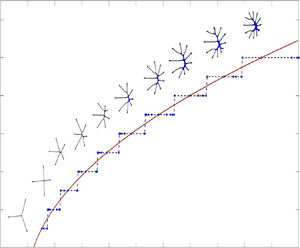Published online by Cambridge University Press: 18 January 2021

The flow in a Hele-Shaw cell with a time-increasing gap poses a unique shrinking interface problem. When the upper plate of the cell is lifted perpendicularly at a prescribed speed, the exterior less viscous fluid penetrates the interior more viscous fluid, which generates complex, time-dependent interfacial patterns through the Saffman–Taylor instability. The pattern formation process sensitively depends on the lifting speed and is still not fully understood. For some lifting speeds, such as linear or exponential speed, the instability is transient and the interface eventually shrinks as a circle. However, linear stability analysis suggests there exist shape invariant shrinking patterns if the gap  $b(t)$ is increased more rapidly:
$b(t)$ is increased more rapidly:  $b(t)=\left (1-({7}/{2})\tau \mathcal {C} t\right )^{-{2}/{7}}$, where
$b(t)=\left (1-({7}/{2})\tau \mathcal {C} t\right )^{-{2}/{7}}$, where  $\tau$ is the surface tension and
$\tau$ is the surface tension and  $\mathcal {C}$ is a function of the interface perturbation mode
$\mathcal {C}$ is a function of the interface perturbation mode  $k$. Here, we use a spectrally accurate boundary integral method together with an efficient time adaptive rescaling scheme, which for the first time makes it possible to explore the nonlinear limiting dynamical behaviour of a vanishing interface. When the gap is increased at a constant rate, our numerical results quantitatively agree with experimental observations (Nase et al., Phys. Fluids, vol. 23, 2011, 123101). When we use the shape invariant gap
$k$. Here, we use a spectrally accurate boundary integral method together with an efficient time adaptive rescaling scheme, which for the first time makes it possible to explore the nonlinear limiting dynamical behaviour of a vanishing interface. When the gap is increased at a constant rate, our numerical results quantitatively agree with experimental observations (Nase et al., Phys. Fluids, vol. 23, 2011, 123101). When we use the shape invariant gap  $b(t)$, our nonlinear results reveal the existence of
$b(t)$, our nonlinear results reveal the existence of  $k$-fold dominant, one-dimensional, web-like networks, where the fractal dimension is reduced to almost unity at late times. We conclude by constructing a morphology diagram for pattern selection that relates the dominant mode
$k$-fold dominant, one-dimensional, web-like networks, where the fractal dimension is reduced to almost unity at late times. We conclude by constructing a morphology diagram for pattern selection that relates the dominant mode  $k$ of the vanishing interface and the control parameter
$k$ of the vanishing interface and the control parameter  $\mathcal {C}$.
$\mathcal {C}$.